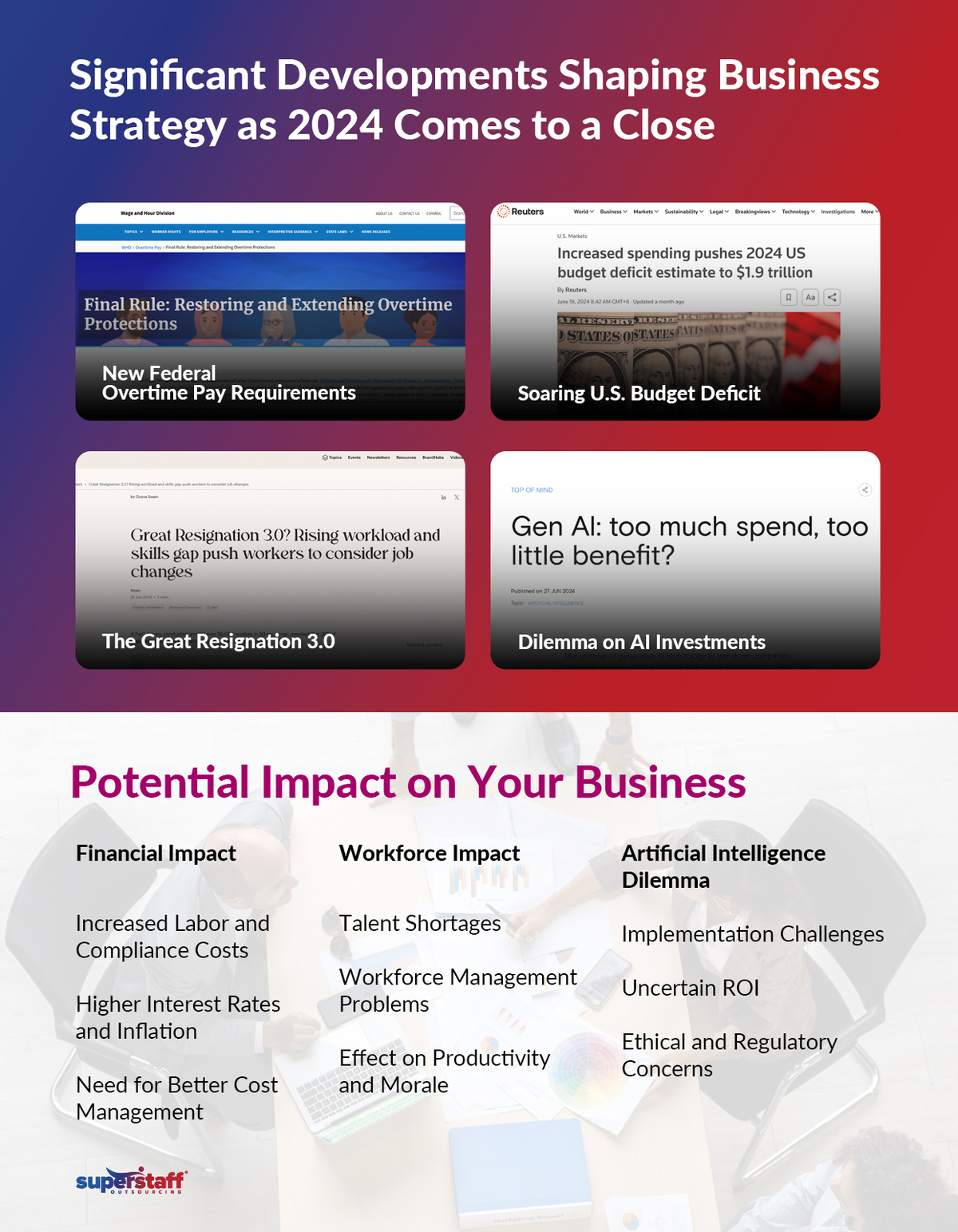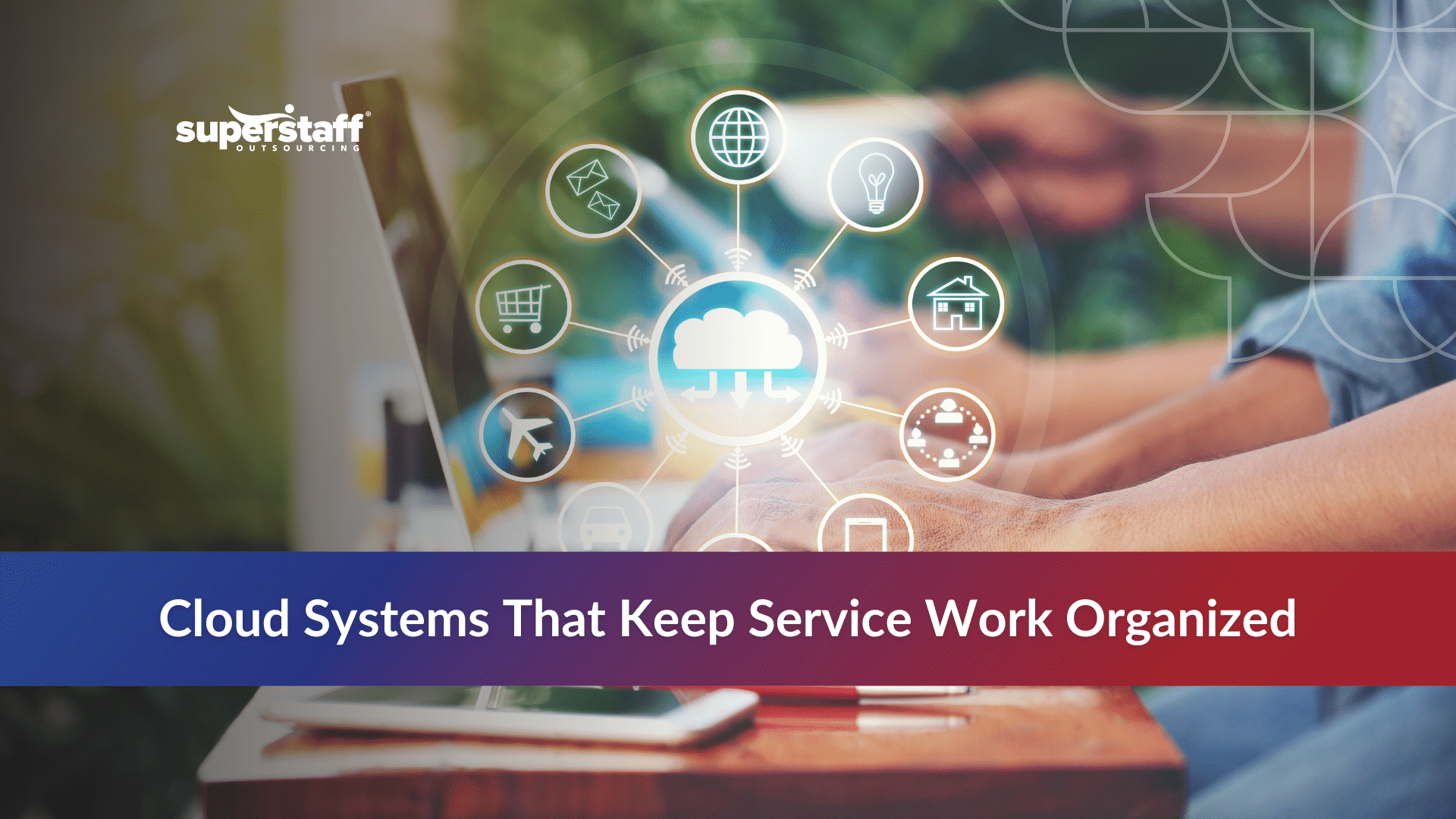
As we approach the midpoint of 2024, companies across the globe are encountering business challenges, ranging from economic fluctuations to evolving market dynamics.
In this environment, companies must remain agile, proactive, and strategic in their decision-making. This period marks an opportune time to take a step back, thoroughly reassess your business strategies, and identify any underlying obstacles that could hinder growth or operational efficiency.
Taking the time to review your organization’s performance to date can reveal key areas for improvement and innovation. Are your current processes aligned with your long-term goals? Are there market shifts that present risks or new opportunities? By addressing these questions, you can begin to build a resilient roadmap for the second half of the year. This approach is not only about risk mitigation but also about capitalizing on new trends and preparing your company for long-term success.
For established enterprises, this might mean refining operational efficiencies, optimizing supply chains, or adopting advanced technologies. For startups, it could involve scaling operations, strengthening customer acquisition strategies, or securing funding for growth. No matter where your business stands, recognizing and addressing these critical challenges is essential to positioning your organization for a prosperous year-end and sustainable growth beyond.
This proactive approach will help ensure that, come year-end, your business is not only surviving but thriving in an increasingly competitive landscape.
Impact of New Federal Overtime Pay Requirements
Effective July 1, 2024, new federal overtime pay regulations mandate that salaried workers earning less than $43,888 annually must receive overtime pay. This change extends overtime protections to more employees, ensuring fair compensation for work beyond the standard 40-hour week.
The Act applies to a fixed, recurring 168-hour workweek, which can begin on any day or at any hour, varying by employee. Employers are prohibited from averaging hours over multiple weeks, and overtime pay must be provided on the regular payday.
While this legislation brings clear benefits to employees, such as improved compensation, it also introduces significant challenges for employers. Let’s explore the potential impacts in more detail:
Increased Labor Costs
The expansion of overtime eligibility will result in higher labor costs for businesses. By January 2025, employers will be required to pay overtime wages to salaried employees earning under $58,656 annually. This change will likely strain payroll budgets, especially for companies with large workforces of salaried employees just below the new threshold. In addition to direct wage increases, businesses will also face administrative costs associated with tracking employee hours and modifying payroll systems to ensure compliance, further inflating operational expenses.
Looking ahead, the earnings thresholds will be updated every three years starting in 2027, reflecting adjustments in worker salaries. This means businesses must be prepared for ongoing financial and administrative adjustments to stay in compliance.
Compliance Costs
In addition to increased labor costs, employers must also manage significant compliance-related expenses. The Act is projected to affect approximately 4 million workers, and companies will need to allocate resources to accurately track employee hours and monitor compliance with the updated rules. Implementing time-tracking systems or adjusting current ones to align with the new regulations could be costly, both in terms of technology and administrative workload.
Legal and consulting fees are also a potential concern. Your HR and legal teams will need to ensure proper compliance by conducting tasks such as reviewing employee classifications, reclassifying those eligible for overtime, and ensuring the accuracy of timekeeping and payroll systems. This administrative burden could place additional strain on your internal teams, increasing costs related to both external consultants and in-house staff.
Workforce Management
While the new overtime regulations may improve employee morale by offering fair compensation for additional hours worked, they also pose workforce management challenges. If not managed properly, the new rules could lead to higher employee workloads or altered schedules, potentially creating stress or dissatisfaction among your staff.
To mitigate these risks, companies may need to consider restructuring their workforce. Shifting responsibilities among employees or limiting overtime hours for part-time workers could help control costs while maintaining productivity. However, these measures must be balanced carefully to avoid negatively affecting employee morale, which could undermine the very benefits these new overtime rules aim to provide.
In conclusion, while the new federal overtime pay requirements are a step forward in ensuring fair labor practices, they also introduce significant financial and administrative challenges for businesses. By proactively addressing these issues through strategic workforce planning and system updates, your company can stay compliant and continue to thrive in this evolving regulatory landscape.

Soaring U.S. Budget Deficits
According to recent reports, the U.S. budget deficit is projected to rise to $1.915 trillion for fiscal year 2024, surpassing last year’s $1.695 trillion deficit and marking the largest gap outside the COVID-19 period. The Congressional Budget Office attributes this 27% increase over previous forecasts to elevated government spending.
This significant budget shortfall carries important implications for businesses. Understanding these impacts is essential for effective planning and decision-making. Let’s explore the key areas of concern:
Interest Rates
With the growing deficit, the government may need to issue more bonds, potentially driving up interest rates. For businesses, this could mean higher borrowing costs, as loans become more expensive. Tighter credit markets may also emerge, making it difficult to secure financing for operational needs or growth initiatives. Companies like yours will need to carefully evaluate borrowing strategies and assess the long-term financial impacts of higher interest rates on cash flow and capital expenditures.
Inflation
A budget deficit of this magnitude could fuel inflationary pressures, driving up the costs of raw materials, supplies, and other essential business inputs. As inflation rises, so do operating costs, which could erode profit margins if not managed effectively. Beyond operational costs, inflation also reduces consumer purchasing power. With higher living costs, consumers may become more selective about where they spend their money, potentially shifting focus away from non-essential goods and services. Businesses will need to sharpen their value propositions to remain competitive in an increasingly price-sensitive market.
Cost Management
As the U.S. budget deficit widens, there is a risk of higher taxes and reduced government spending on programs that benefit businesses. These factors, combined with rising interest rates, may increase financial pressures. Effective cost management will be critical. Companies must evaluate their budgets, streamline processes, and find ways to enhance operational efficiency to offset rising costs. Proactive measures, such as renegotiating supplier contracts or investing in automation, may help mitigate some of the financial strain.
Strategic Planning
The uncertainty surrounding the U.S. budget deficit complicates long-term strategic planning. Shifts in tax policies, government spending, and fiscal priorities could impact business investments and consumer spending habits. Higher taxes or reduced public sector spending may lead to diminished consumer confidence, affecting demand for products and services. Inflation and fluctuating interest rates further complicate financial planning, making it essential for companies to adopt more cautious or flexible strategies. Businesses must be prepared to adjust to potential economic volatility by building contingency plans, diversifying revenue streams, and staying agile in their approach to market changes.
In conclusion, the rising U.S. budget deficit poses multiple challenges for businesses, from increased borrowing costs to inflationary pressures and tax uncertainty. By understanding these implications and adjusting strategies accordingly, companies can navigate the economic turbulence and continue to thrive despite fiscal challenges.
The Great Resignation 3.0
The Great Resignation, a phenomenon where employees voluntarily left their jobs, switched careers, or exited the workforce for various reasons, had a significant impact on businesses and the labor market. In 2022 alone, approximately 50 million workers resigned, creating widespread disruption.
Fast forward to 2024, and a new term has emerged —”The Great Resignation 3.0″ — which signals a third wave of resignations and staffing shortages. This wave threatens to intensify the challenges businesses face in attracting and retaining talent.
Let’s explore the potential effects of The Great Resignation 3.0 on your business:
Talent Shortages
Korn Ferry estimates that by 2030, there will be a global talent shortage exceeding 8.5 million workers, with the potential to cause $8.5 trillion in revenue losses if the issue is not addressed. As The Great Resignation 3.0 unfolds, recruiters will face even greater difficulties in finding qualified candidates, leading to prolonged hiring times and increased recruitment costs. This shortage is not just a temporary inconvenience; it could become a long-term challenge that affects your company’s ability to scale and innovate.
For businesses, this means adopting more creative and strategic approaches to talent acquisition, such as offering remote work options, upskilling existing employees, and partnering with specialized staffing firms. Without these measures, the competition for top talent will become more fierce, and your company could struggle to maintain growth.
Higher Labor Costs
A study by PwC reveals that 28% of workers are likely to switch employers next year — significantly higher than the 19% seen during the height of The Great Resignation. To remain competitive in this evolving job market, companies will need to offer not only higher wages but also better benefits and flexible working conditions. The costs associated with these improvements will be substantial, and they don’t stop with increased salaries. Recruitment and onboarding expenses will rise as businesses spend more to attract the right talent. Additionally, training new hires will require both time and resources, further driving up operational costs.
In this environment, companies must strategically manage their compensation structures, balancing the need to attract talent with maintaining profitability. Proactive investments in employee development and engagement can help reduce turnover, thereby offsetting some of the increased labor costs.
Decline in Customer Satisfaction
High employee turnover has a direct impact on customer satisfaction and loyalty. Research shows that companies with lower turnover rates can achieve up to 55% higher profits, largely due to increased customer satisfaction. A stable workforce allows for better service consistency, deeper customer relationships, and a stronger brand reputation.
In contrast, businesses experiencing high turnover may struggle to deliver a seamless customer experience, which can lead to customer dissatisfaction and erosion of loyalty. As employees leave, valuable institutional knowledge is lost, and frequent staffing changes can create service disruptions that frustrate clients. By focusing on employee retention strategies, such as offering career development opportunities, fostering a positive work culture, and ensuring competitive compensation, you can improve both employee retention and customer satisfaction — ultimately driving profitability.
In summary, The Great Resignation 3.0 poses significant challenges, from talent shortages and increased labor costs to the risk of declining customer satisfaction. Businesses that proactively address these issues through strategic talent management, compensation planning, and customer-focused initiatives will be better positioned to thrive in the face of these labor market disruptions.
Dilemma on AI Investments
What challenges do both small businesses and large enterprises face today? One of the most pressing issues is whether to invest in artificial intelligence (AI). As AI technologies evolve, they offer significant business opportunities, including increased efficiency and enhanced innovation. However, these opportunities come with substantial risks and costs, creating a complex dilemma for business leaders: Should you invest in AI?
Let’s delve deeper into the potential drawbacks and risks of AI implementation:
High Initial Costs
Implementing AI requires a substantial upfront investment in hardware, software, and infrastructure. A report by Goldman Sachs estimates that the total cost for AI infrastructure could exceed $1 trillion. Beyond these initial expenses, companies must also account for the cost of training employees to effectively use AI technologies. For businesses of any size, these financial commitments can be daunting, especially if the return on investment (ROI) is uncertain.
Uncertain ROI
The potential return on AI investments is another critical concern. According to the same Goldman Sachs report, AI is expected to impact less than 5% of all tasks, and only about 25% of AI applications are projected to be cost-effective. Given the high costs — especially the estimated $1 trillion for infrastructure—some experts argue that AI may not be the most efficient solution for tasks that could be handled more cost-effectively by human labor. Additionally, there is the risk of AI projects failing, which could result in significant financial losses. This uncertainty makes it essential for businesses to carefully weigh the potential benefits against the risks before committing to large-scale AI investments.
Complexity and Implementation Challenges
Integrating AI into existing business systems is not without its challenges. For companies using outdated technology, the introduction of AI may disrupt established processes, requiring substantial changes across operations. Moreover, implementing AI successfully demands a high level of technical expertise, including skills in programming, machine learning, database modeling, and intelligent user interfaces. Unfortunately, not all businesses have access to this expertise in-house, making it difficult to leverage AI-driven solutions.
Outsourcing AI and machine learning (ML) development to external teams can offer a viable solution, allowing businesses to accelerate their AI projects while managing costs. However, outsourcing also comes with its own set of challenges, including finding reliable partners and maintaining control over project quality and data security.
Ethical and Regulatory Concerns
Another significant challenge with AI is addressing ethical and regulatory concerns. AI systems, if not properly managed, can perpetuate or even amplify biases inherent in the data used to train them. This can lead to ethical issues, particularly in areas such as hiring, customer service, and decision-making processes. Businesses must ensure that their AI systems are designed to minimize bias and operate transparently.
In addition to ethical considerations, companies must navigate an increasingly complex regulatory landscape. Compliance with data privacy regulations and AI-specific guidelines is crucial to avoid potential legal penalties. As governments around the world begin to implement more stringent AI and data protection laws, companies will need to invest in legal and compliance resources to ensure adherence to these regulations.
While AI presents exciting opportunities for businesses, it also brings significant risks and challenges. High upfront costs, uncertain ROI, implementation complexities, and ethical and regulatory concerns must all be carefully considered before investing in AI. To make informed decisions, companies should conduct thorough analyses, create detailed implementation strategies, and assess the potential long-term impacts on their operations. By approaching AI investment strategically, businesses can harness its benefits while minimizing risks and maximizing value.
Tackle These Business Challenges With a Scalable and Cost-Efficient Approach

As the year draws to a close, your business may be facing a range of complex challenges. Key industry developments — including the new federal overtime pay requirements, rising U.S. budget deficits, the ongoing impacts of the Great Resignation, and the increasing adoption of AI — have the potential to disrupt your operations and hinder your ability to achieve business goals.
At SuperStaff, we specialize in helping companies navigate these challenges through scalable outsourcing solutions tailored to meet your unique needs. Our cost-efficient processes empower your business to expand its capabilities while maintaining focus on core operations. By strategically addressing pain points, we ensure that your organization can operate at maximum capacity without being weighed down by rising costs or operational inefficiencies.
Partner with SuperStaff today and let us help you strengthen your business for the rest of the year and beyond. With our support, you can stay agile, optimize performance, and turn potential disruptions into opportunities for growth.






